The Cardboard Republic has rolled out the annual Laurels of the Republic awards, celebrating the best new games released in 2017 for each of the gamer archetypes. What follows are the finalists for one of those groups.
 From the depths of a cavernous dungeon, to the cold reaches of a distant conflict in outer space, to the exploration of the human condition, Immerionists thrive on a game’s setting. This group gets its biggest enjoyment out of games with rich settings that either tell some kind of story or serve some kind of purpose – games existing solely on basic mechanical or tactical choices are their kryptonite. Their driving interest revolves more around whether a particular mechanic or component fits whatever narrative is being told than if it’s the most ideal option. Immersionists want to be part of the game and feel as if their character belongs there. These roleplayers and worldbuilders demand that flavor actually matter to hold their interest – something more designers have been taking to heart in recent years.
From the depths of a cavernous dungeon, to the cold reaches of a distant conflict in outer space, to the exploration of the human condition, Immerionists thrive on a game’s setting. This group gets its biggest enjoyment out of games with rich settings that either tell some kind of story or serve some kind of purpose – games existing solely on basic mechanical or tactical choices are their kryptonite. Their driving interest revolves more around whether a particular mechanic or component fits whatever narrative is being told than if it’s the most ideal option. Immersionists want to be part of the game and feel as if their character belongs there. These roleplayers and worldbuilders demand that flavor actually matter to hold their interest – something more designers have been taking to heart in recent years.
And with that, here are The 2017 Laurel Finalists for Immersionists:
Honorable Mention: Mountains of Madness
Publisher: IELLO | Players: 3-5 | Play Time: 60-90 Minutes
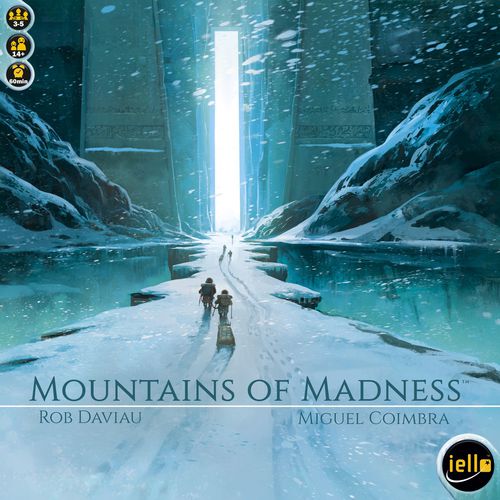
Thanks to the endless creativity and inspiration of designers, we are continually rewarded with new combinations of mechanics, components, artwork, and worlds to explore. Tet there are some game themes that are so widespread and so common, that they’ve almost reached trope level in how often we see them. Farming and zombies. Vikings and Medieval cities. And of course, the most otherworldly of them all: Cthulhu. The Lovecraftian theme of cosmic horror is so ubiquitous in gaming that it’s become the go-to theme of choice for people wanting to reskin into something more mysterious and spooky and all together ooky.
The problem is so many of these titles focus on the flavor and mechanics surrounding eerie happenings and the inevitable descent into madness, few truly capture that all-important feeling of insanity. Mountains of Madness does exactly that.
Based on the short story, in this crazy Co-Op game players are a team of explorers who have landed at the foot of a mysterious mountain. Each turn your team must overcome the encounter at your location by collectively contributing the right types and amounts of cards from your hands in a real-time fashion. However, each person has a Madness – a behavioral quirk that changes over the course of the game that will make you say or do something odd during those moments – turning a simple matching effort into something much more, well, unpredictable. The further along you get, the weirder your companions start acting.
Although met with some trepidation due to crossed expectations, Mountains of Madness embodies the essence of Lovecraftian irrationality and imparts it onto players better than almost any other Cthulhu-based game. With a simple premise compounded by erratic, zany, and occasionally frustrating conditions, this is one adventure where Immersionists will enjoy the ride even more than the destination.
The Nominees

Number Five: Nemo’s War (Second Edition)
Publisher: Victory Point Games | Players: 1-4 | Play Time: 60-120 Minutes
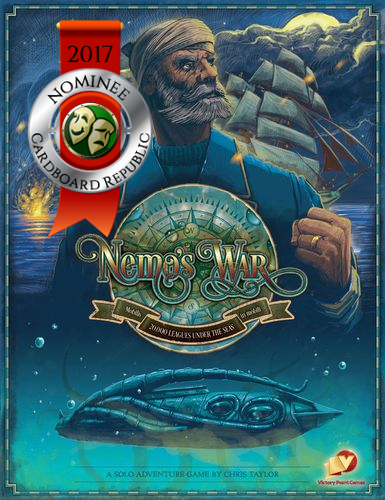
Board games can take their themes from many places. Some are reenactments of real historical events. Some are completely made up worlds featuring dragons and gnomes and more ghosts than a Sooby-Doo marathon. And then there are those who decide to try their hand at adaptation. Usually this takes the form of licensed material such as movies and TV shows, but every now and then you get a game like Nemo’s War, which adapts the early sci-fi novel Twenty Thousand Leagues Under the Sea.
Nemo’s War (despite what the player count may say) is a solo game where you set sail for a year-long voyage helming the Leviathan as Captain Nemo. This version makes a substantial overhaul to pretty much every aspect of the original 2009 version while still being able to call it the same game. Each playthrough allows you to focus on different aspects of Nemo’s character, from his love of science and exploration to his decidedly anti-Imperialist rhetoric, giving you different point-scoring opportunities each session. Mechanically straightforward and easier to grasp than it first seems, most of the game is a slate of meeting various skill checks. Essentially, over the course of the game you’ll roll dice and overcome a host of thematic encounters, from flavorful card-driven events and hostile warships prowling the open seas.
Yet Nemo’s War shines as a game that takes you through the dynamic captain’s journey. What makes the game so worthwhile, especially for Immersionists, is just how much of the book’s thematic resonance comes through during this not-quite-three-hour tour. Each instance puts you in Nemo’s shoes and has you wholly embrace that role, whether you choose to roam the ocean as a benevolent explorer or a revolutionary looking to stir up regional conflicts. How the story unfolds is entirely up to you.
Number Four: Near and Far
Publisher: Red Raven Games | Players: 2-4 | Play Time: 60-120 Minutes
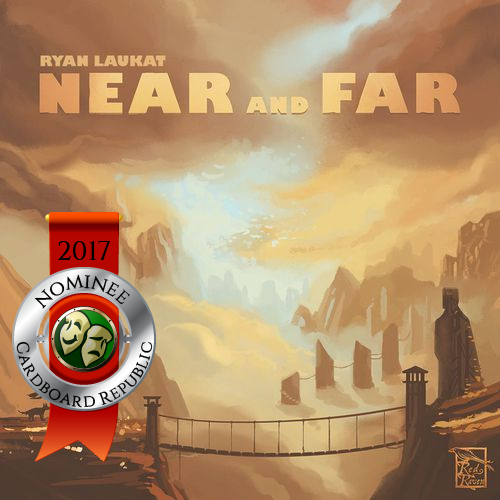
2017 was a banner year for campaign games, with five titles on our nominee list and many others that were under consideration. But if done well, it’s only fair to champion their efforts.
Near and Far is done exceedingly well.
In this highly enjoyable sequel to Above and Below, players have left behind the lands of the previous game to in search of the fabled Last Ruin, a lost city containing a treasure of mystical proportions. This Magical MacGuffin supposedly is able to reward those who possess it with their heart’s greatest desire, which of course creates not only a race between players to find it, but also a journey to see if their intentions for finding it are pure.
After all, who knows what manner of less-than-reputable folk could get their hands on it?
Spanning nearly a dozen linked scenarios, players journey across the land as you – quite literally – move through the game’s storybook. During that time you’ll search for treasure, gather companions, stockpile food, and ensure you have the necessary equipment to overcome the litany of obstacles you’ll face along the way.
All of this is conveyed through a combination of scenario maps and brand new book of encounters. Heavily expanding on the original storyline elements from Above and Below, Near and Far routinely presents players with flavorful story-based moments that directly impact how their character grows throughout the adventure. For Immersionists, it’s hard not to love the slowly developing thematic worldview presented with each successive playthrough. From bandit lords to forgotten robots to riches long abandoned, the world of Near and Far is like a colorful pop-up book where the story shines even more than the straightforward mechanics. In this game, the experience of finding the Last Ruin is every bit as rewarding as the race to get there.
Number Three: Fog of Love
Publisher: Hush Hush Games | Players: 2 | Play Time: 60-120 Minutes
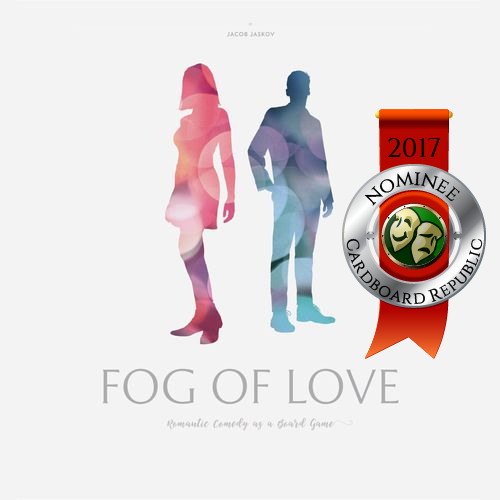
Fog of Love is not a game most people saw coming when it originally debuted on Kickstarter. Rather than walk down the well-trodden aisle with typical themes, it instead offered up a solid, detailed game about passion, romance, and the nuances that go into maintaining a relationship, all baked into the narrative model of your typical romantic comedy.
Honestly, the game deserves praise for the originality alone.
In this two-player game of shakeups and makeups, you and another player journey through the span of a couple’s romantic time together, from the early days of rose-colored everything to some of life’s more challenging and unpredictable moments. Your goal is to see if you have what it takes to maintain that relationship whilst finding ways for your character to grow as a person. Will things endure, or are you doomed to fail?
Through a series of storyline prompts, Fog of Love continually blends a mechanics-driven narrative with light roleplaying aspects, giving you everything you need to fully embrace a love-stricken alter ego. And thanks to a healthy dose of card variety, gender-neutral player combinations, and fairly open-ended storytelling, this is one rom-com that’s brimming with replayability.
Fog of Love isn’t for everyone, but for Immersionists, this is the precisely the kind of two player game they’ll easily be infatuated with. This is a game that’s equal parts game and immersive journey. Using a mix of straightforward decision-making mechanics and lofty flavor, Fog of Love guides both players through a self-tailored cinematic of love, romance, and the challenges necessary to keep those things alive. It captures a wondrous sense of character evolution while maintaining a pleasant tone, all as it building towards the inevitable ‘Will They Or Won’t They’ movie moment.
Is it a bit cheesy? Sure. But so is love.
Number Two: The 7th Continent
Publisher: Serious Poulp | Players: 1-4 | Play Time: 60-60,000 Minutes

The 7th Continent is somewhat of a strange game to include on this list, due to its unique status as a Kickstarter-only game. Thanks to its massive scope and size, the designers at Serious Poulp determined that it simply wasn’t feasible to attempt traditional distribution. Thankfully though it still fit our vetting criteria, which means we get to celebrate this unprecedented paragon of analog game exploration.
If you’ve ever wanted to play King’s Quest in board game form, now’s your chance.
The 7th Continent is the rare example of a game that eschews the common wisdom that less is more. In this cooperative exploration game, players have been stricken with a strange curse. In the hopes of curing it, you embark on a lengthy adventure into unknown lands of the newfound seventh continent. Whether played solo or as part of a D&D style entourage, the process is the same: over the course of the game you will spend your precious time exploring a seemingly endless array of map tiles, overcoming challenging, discovering treasures, upgrading equipment, and simply trying to survive.
What makes the game so impressive, especially to Immersionists, is the grand vision it lays before you. Beyond an overarching storyline, there are no handrails to force you onto a specific path. Instead, the game lets you step out into the world and then quickly envelops you with its wondrous sandbox-style setting. Worldbuilding lies at the very heart of this title, and theme becomes richer the longer your adventures go.
7th Continent is ambitious, creative, flavorful, and has hundreds of hours of play time at its disposal, making it very every bit worthy of its runner-up status. But in 2017, there was another game that just slightly tops it in the thematic department, albeit in a wholly different way…
The Winner
2017 Immersionist Laurel – This War of Mine: The Board Game
Publisher: Galakta Games / Distributor: Ares Games | Players: 1-6 | Play Time: 45-120 Minutes
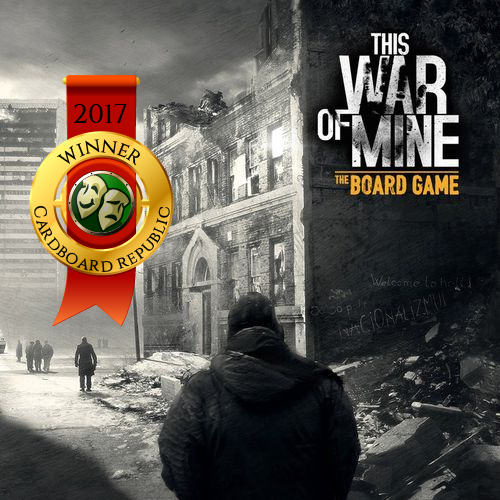
War is Hell. It’s been a phrase for decades as a succinct description of conditions on the ground, a philosophical anecdote about how there is no such thing as a ‘good’ war, and an apt reminder for the future that it’s always best to avoid it if at all possible.
You’d think humans would have taken that lesson to heart over the centuries, but…we don’t. The details may change with each generation, but the insatiable desire to resort to armed conflict when all else fails is one of the most common traits stretching across all of human civilization. What’s worse is that most of the time, those conflicts are glorified, glossing over the real world tolls most wars have on those who live through them.
This War of Mine doesn’t just try to remind you that not everyone in war is a soldier; it bludgeons you over the head with that fact.
Based on the award-winning video game of the same name, This War of Mine is a heady Co-Op based around the Bosnian war of the mid 1990s. In this game, players are citizens merely trying to endure until the cessation of hostilities. During the day you’ll upgrade your location, while at night you’ll venture outside to gather whatever resources you can and randomly encountering other people in the process – each of whom comes with unique story elements.
There are few games that tackle such real world issues, and even fewer that do it in a manner that’s both laudable, deep, and thoroughly entertaining (at least in small doses). This War of Mine illustrates with a rich but serious candor that war is indeed Hell. Expanding upon the video game, This War of Mine is an incredibly thematic experience full of eye-opening and gut-wrenching situations where there often isn’t an ideal solution. Your group must do what it takes to not only survive but to do it in a way that leaves your humanity intact. For Immersionists, there simply was no better example in 2017 of how much game’s theme can truly matter when done correctly, leaving little doubt why This War of Mine has easily and rightfully earned this group’s Laurel.
![]()
This War of Mine Contest!
We thought about different ways to highlight how great the winning title of the Immersionist Laurel is. We tried to come up with some clever and thematic ideas, such as turning our favorite board games into a Broadway musical or attempting to convert our friend’s 15 year D&D campaign into a 1,000 scenario based adventure game. But then we remember that those sort of things would take a lot of time and money. So we’ve opted for a simpler approach instead: providing one lucky winner with the opportunity to enjoy the award-winning game first hand.
That’s right! Enter below for your chance at your very own copy of This War of Mine!
Note: In honor of their award recognition, Ares Games and Galakta Games has kindly provided a copy of this game for giveaway purposes.
![]()
Be sure to check out the 2017 Laurel Award pages for the other archetypes once they go live!







